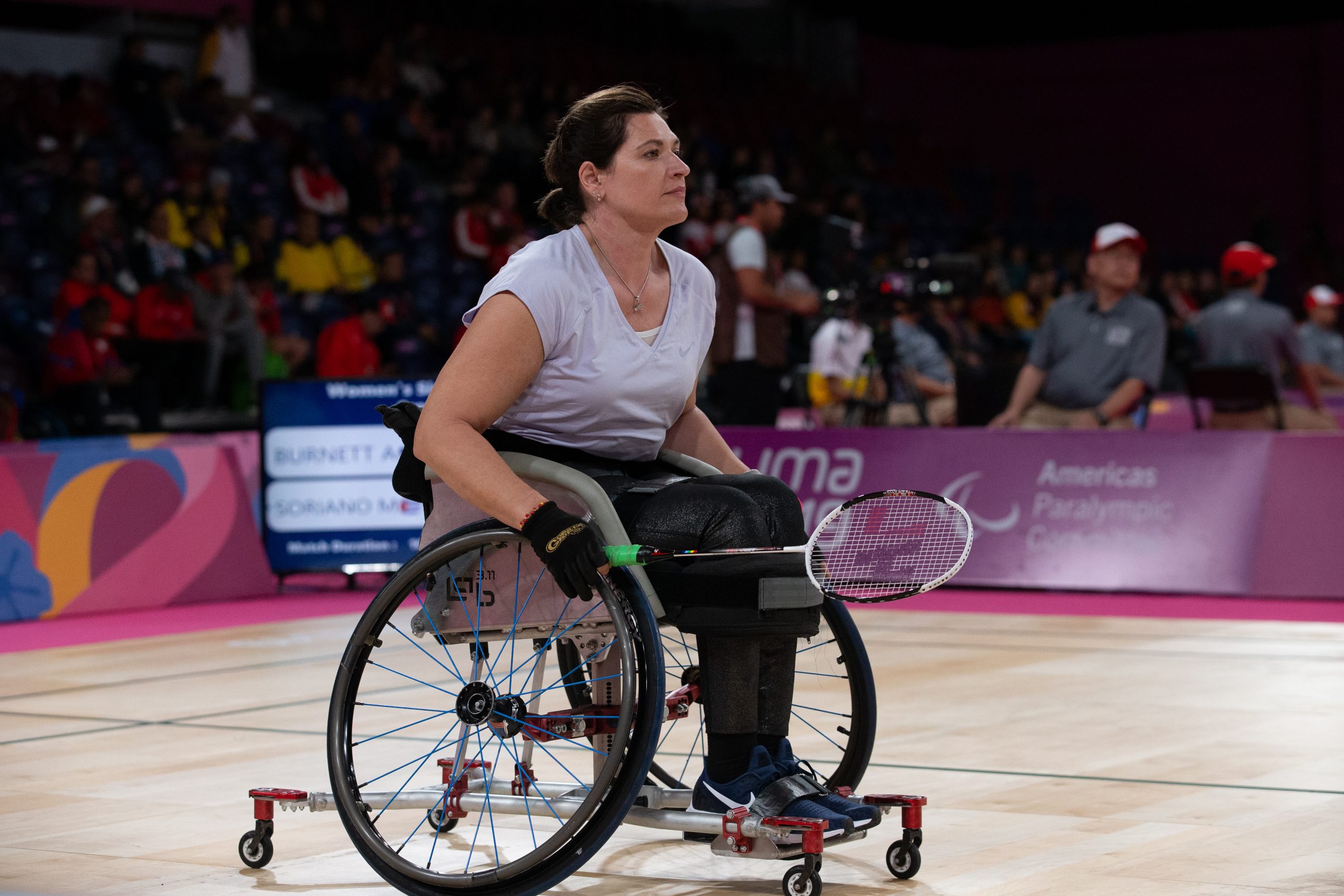
Badminton
More Than a Backyard Sport
You may be familiar with the game of badminton. Many schools teach the sport in physical education class. It is also often played at family reunions, on beaches, and in backyards across the country. But for many, that is the extent of it. Not everyone knows that it is a highly competitive sport all over the globe. In fact, according to Team USA Para-Badminton Athlete Amy Burnett, it is the second most popular sport in the world. But it is for the reasons mentioned above that Burnett, who is currently the only wheelchair athlete representing the U.S. in international play, wanted to play. “It is a sport that is associated with a lot of fun.”
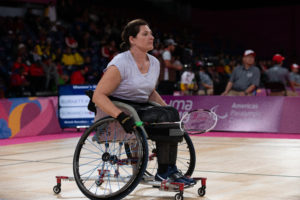 Steve Kearney, the director of Para-Badminton for USA Badminton, admits the sport is much larger in Europe and Asia, but is hoping the fact that the sport is making its Paralympic debut in Tokyo will change that in this country.
Steve Kearney, the director of Para-Badminton for USA Badminton, admits the sport is much larger in Europe and Asia, but is hoping the fact that the sport is making its Paralympic debut in Tokyo will change that in this country.
Para-Badminton is a flexible sport. It can be an individualized sport, where it is one-on-one on the court in singles play or athletes can play doubles or mixed doubles. Kearney also says it is a lifelong sport.
PLAYING BY THE RULES
There is a relatively easy point of entry to the sport. The basic equipment is a racket and a plastic shuttlecock, which can be purchased for little cost at most sporting goods stores. That’s pretty much it.
Competitively, para-badminton is played indoors typically on a 44 x 20 court with a net. A point is scored every time you serve. The first to score 21 points wins the game and the best two out of three wins the match. Matches typically don’t last a long time, according to Burnett. “Most matches are under 30 minutes.”
Kearney equates the sport to chess a bit. “You have to analyze quickly and adjust accordingly,” he said. It is also a very physical sport. “You are moving all the time and constantly playing,” Kearney said.
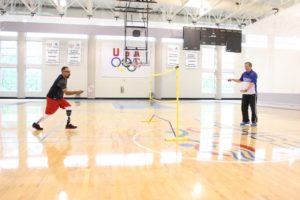 Richard Alcaraz, who served in the U.S. Marines from 1990-1995, was introduced to para-badminton in 2016 at a sports camp for veterans at Lakeshore Foundation, a member of the Move United member network. Alcaraz, who represents Team USA in one of the standup classifications as a below-knee amputee, agrees that it is quite a workout. “Every time I train, I feel like I’m doing a 5k or 10k while on the court.” In addition to the foot movement, he mentions the importance of hand-eye coordination and wrist skills.
Richard Alcaraz, who served in the U.S. Marines from 1990-1995, was introduced to para-badminton in 2016 at a sports camp for veterans at Lakeshore Foundation, a member of the Move United member network. Alcaraz, who represents Team USA in one of the standup classifications as a below-knee amputee, agrees that it is quite a workout. “Every time I train, I feel like I’m doing a 5k or 10k while on the court.” In addition to the foot movement, he mentions the importance of hand-eye coordination and wrist skills.
Of course, your object is keeping the shuttle in the court. There are different types of swings, including a drive shot and a smash.
In doubles (men’s, women’s, or mixed), it is important to get to know your partner. “You have to build trust,” Kearney said. “You learn who is going to hit and where, and you get to know where your partner is going to be on the court.” The benefit of playing doubles is that you have two people to cover the court. “When you play singles, you are covering the whole court by yourself,” Alcaraz said.
One of the many benefits of sport is the sense of community, and in para-badminton that is no exception. “We are a close-knit group of people with different disabilities,” Burnett said. “But we forget that we like each other when we are on the court.”
ADAPTATIONS
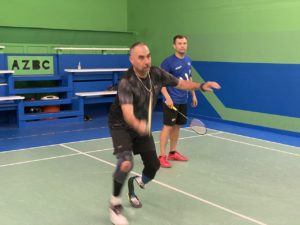 The normal rules of badminton apply. There are six classifications, including two wheelchair categories, dwarfs, and three amputee categories (BKA, AKA, and above waist). Wheelchair players may be fixed to the chair with a strap around the thighs or waist, or both. But the player’s feet must be fixed to the footrest of the wheelchair. Burnett also points out a few other adaptations. “We play on half a court (in singles play) and the front service line (the first six feet from the net) is considered out of bounds.”
The normal rules of badminton apply. There are six classifications, including two wheelchair categories, dwarfs, and three amputee categories (BKA, AKA, and above waist). Wheelchair players may be fixed to the chair with a strap around the thighs or waist, or both. But the player’s feet must be fixed to the footrest of the wheelchair. Burnett also points out a few other adaptations. “We play on half a court (in singles play) and the front service line (the first six feet from the net) is considered out of bounds.”
PARALYMPIC PURSUITS
The U.S. Para Badminton Team is looking to expand the number of players. Kearney says there are about 16 athletes that compete nationally and internationally currently.
If you are interested in competing in the sport, Kearney suggests a number of things you can do. First, you may want to upgrade your equipment. “As you get better, you will want a lighter racket strung at the highest level of tension.” There are different types of strings. And in competition, the shuttlecock is not made from plastic, but is made of feathers.
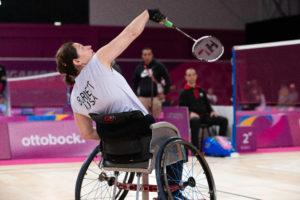 You may also want to get a coach to help you train. Burnett spends about six hours a day in the gym, between private lessons, pushing drills, and weight training. “Quickness on court would help me a lot.”
You may also want to get a coach to help you train. Burnett spends about six hours a day in the gym, between private lessons, pushing drills, and weight training. “Quickness on court would help me a lot.”
And of course, you will want to enter competitions. “There are many opportunities to play in tournaments,” Kearney said. “Just about every weekend.” In addition, you will need to get classified early in the process as well.
WHERE TO PLAY
There are a handful of Move United member organizations that offer para-badminton programs. You can learn more by going to moveunitedsport.org and search “badminton.” You can also check out usabadminton.org and click on “where to play” to find a badminton club near you. USA Badminton offers demos and clinics throughout the year for beginners as well.
Alcaraz hopes people will shun the perceptions they may have about the sport. “I remember being asked if that was the game you play when you’re camping,” he said. “I was also asked if you have to wear white shorts and collared shirt.”
It’s time for you to redefine the sport. So, get on the court and get in the game.
NOTE: This article originally appeared in the Spring 2021 issue of Move United magazine. To see the full article, click here.

